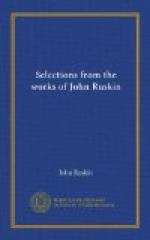Now, it is not possible—and I repeat to you, only in more deliberate assertion, what I wrote just twenty-two years ago in the last chapter of the Seven Lamps of Architecture—it is not possible to have any right morality, happiness, or art, in any country where the cities are thus built, or thus, let me rather say, clotted and coagulated; spots of a dreadful mildew, spreading by patches and blotches over the country they consume. You must have lovely cities, crystallized, not coagulated, into form; limited in size, and not casting out the scum and scurf of them into an encircling eruption of shame, but girded each with its sacred pomoerium, and with garlands of gardens full of blossoming trees and softly guided streams.
[187] In Modern Painters, vol. 1.
[188] The quotation is from Vasari’s
account of Angelico’s Last
Judgment (now in the Accademia at Florence).
[Cook and Wedderbum.]
[189] Song of Solomon i, 6.
[190] Cf. Classical Landscape, pp. 92-93.
[191] Isaiah, ii, 4; Micah iv, 3; Joel iii, 10.
[192] The name of St. George, the “Earthworker,”
or “Husbandman.”
[Ruskin.]
[193] Luke xxiv, 35.
[194] Virgil, AEneid, 3, 209. seqq. [Ruskin.]
[195] Acts xiv, 17.
[196] Psalms i, 3.
[197] Genesis xxiv, 15, 16 and
xxix, 10; Exodus ii, 16; John
iv, 11.
[198] Osborne Gordon. [Ruskin.]
ART AND HISTORY
ATHENA ERGANE
This short selection is taken from the volume entitled The Queen of the Air, in which Ruskin, fascinated by the deep significance of the Greek myths and realizing the religious sincerity underlying them, attempts to interpret those that cluster about Athena. The book was published June 22, 1869. It is divided into three “Lectures,” parts of which actually were delivered as lectures on different occasions, entitled respectively “Athena Chalinitis” (Athena in the Heavens), “Athena Keramitis” (Athena in the Earth), “Athena Ergane” (Athena in the Heart). The first lecture is the only one which keeps to the title of the book; in the others the legend is used merely as a starting-point




